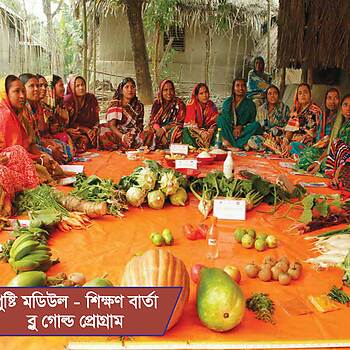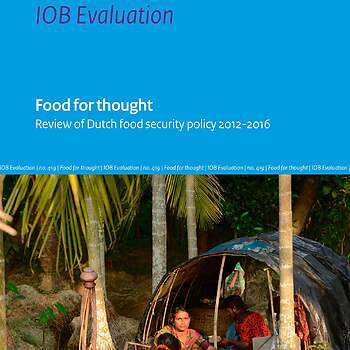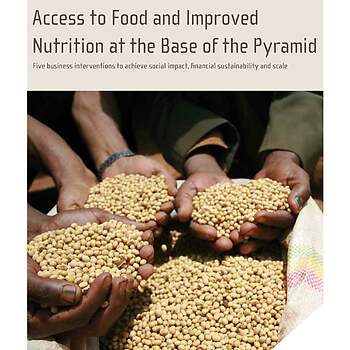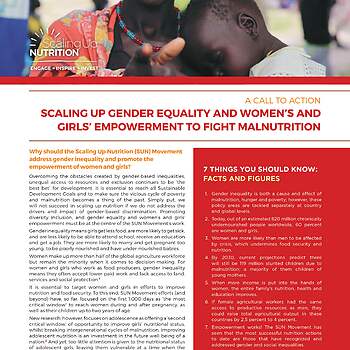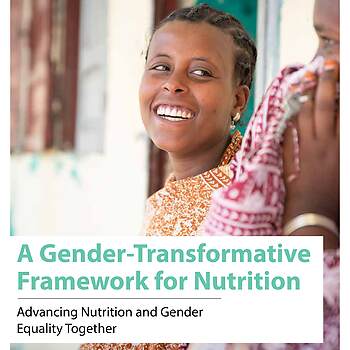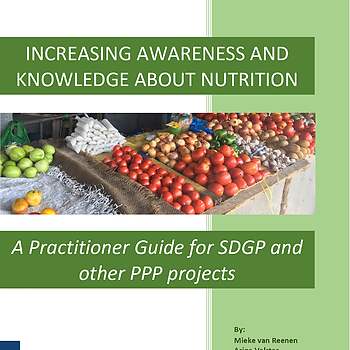Nutrition initially not linked to agriculture
Technical solutions: The first decades of development cooperation (especially the 50s and 60s) aimed on increasing agricultural production by improved technologies such as those promoted by the Green Revolution. This led to increased total food production and better incomes for certain categories of farmers. But it also came with significant costs for others, such as women, landless and certain other categories of (small) farmers. Reasons for negative impacts were often due to gender and class biases in policies and practices. These reasons include the shift to cash crops, the need for cash to buy inputs, and the mechanization reducing labour opportunities -and thus income- for the poor. This meant that the Green Revolution did not end hunger and malnutrition.
Nutrition as health issue: In the next decades of Dutch development policy -till the mid 1990s- attention to nutrition increased, but within the domain of health care. This followed the UNICEF conceptual framework, focusing on mother and child care, for example, by addressing children’s malnutrition. At this time nutrition was usually seen as separate from agricultural production and marketing of food.
Nutrition as part of food security: In 1996 the UN developed a more integrative definition of food security, consisting of four pillars. This also recognized that intra-household distribution, including gender-based discrimination, is a key factor influencing food security. MFA started to follow this concept.
No automatic impact of food production or increased incomes on nutrition: Till 2008 the common assumption -including in Dutch policies- was that more income would lead to better and equal utilization of food within the household. However, practice showed that often the incidence of ‘stunting and wasting’ (underweight, especially among children) hardly reduced with increased incomes. Therefore, more explicit attention to the food utilization pillar (nutrition) was considered imperative. Apart from insufficient knowledge and awareness about nutritional values of food items, also intra-household dynamics caused malnutrition, in particular among women and girls.
Example from Bangladesh: Early marriage is still common, even though there is awareness that when adolescent girls have to give birth, there is an increased risk on complications. Therefore, family members, in particular mothers-in-law, traditionally advise pregnant girls to eat less and avoid certain foods, so the baby won’t be big and delivery is less complicated. However, this leads to undernourished young mothers, whereas the new-borns are underweight already at the time of birth.
Link food utilization & food security and gender equality
Gender sensitive food security programs and gender specific research, especially by research institutes and NGOs, led to better understanding of the links between nutrition and food security and gender equality and women’s empowerment. On the one hand, food security and adequate nutrition are needed for women’s empowerment. On the other hand, gender equality and women’s empowerment are instrumental to end malnutrition and hunger.
Gender issues related to food security and nutrition include:
- As farmers, women play a key role in producing nutritious food. In many societies women traditionally cultivate(d) food crops on fields and vegetables in homestead gardens, while men focused on cash crops. Women may also sell fresh or processed food in local or regional markets.
- As mothers and customers, women often buy and prepare food for their families and children. In several societies, however, men decide and/or actually buy food on the market.
- Women’s knowledge, power and access related to nutritious food (quantity and quality) is often insufficient. Men’s access to food often differs from women’s, but they also lack knowledge.
- Women and girls tend to be over-represented among those living in food insecurity. Women in female headed households often have less access to resources for agricultural production. They tend to live in greater poverty and have less means for buying (nutritious) food. In male headed households, food distribution among household members is often not equal. This is especially in times of food shortages, when women take less food or less nutritious food than men, “sacrificing themselves”. Taboos on food, such as during pregnancy, may also inhibit women’s health.
This means that women need adequate information and decision-making power on nutritious food and have access to such food. But also men need to be aware and decide accordingly on the importance of nutritious food for the whole family, including for women and children, also because of their responsibility as fathers.
More attention of MFA to all pillars of food security, including nutrition
As a result of the world food crisis in 2008 and lobby by Dutch NGOs, MFA started paying more attention to all four pillars of Food Security. They supported the first ‘Nutrition for Growth’ or N4G Summit in 2013, during which 110 stakeholders pledged to fund robust nutrition specific or sensitive projects. Related to this development is the multi-donor and multi-stakeholder initiative called Scaling Up Nutrition (SUN) which was launched in 2010. MFA and various Dutch NGOs became active members.
Throughout the years, MFA’s financial support to nutrition has been channelled through embassies and multilateral organisations like UNICEF, FAO, IFAD and IFPRI, and through NGOs. Later on, multi-stakeholder platforms such as AgriProFocus* and partnerships programmes such as the Global Alliance for Improved Nutrition (GAIN) became important funding vehicles for MFA.
Role of Dutch NGOs: With financial support from MFA, the Dutch multisectoral NGOs -Cordaid, Hivos, ICCO and Oxfam Novib- have always supported food security programmes. Initially through the broad based MFO co-financing programme, which existed till 2011. Given their broad-based and integrative approach, a focus on nutrition was often included. Programmes were co-designed and implemented by local partner organisations. The gender specialists of the Dutch NGOs and their local partners were instrumental in ensuring that many programmes paid special attention to women and gender equality, either through direct implementation on the ground or lobby and advocacy. After 2011 these NGOs, as well as more sectoral ones, developed and implemented programmes addressing food security in the context of specific subsidy programmes launched by MFA. Examples are the Power of Voices Partnerships programme (with food security as an eligible theme) and the Facility for Sustainable Entrepreneurship and Food Security (FDOV), see below. Next to MFA funding, Dutch NGOs also applied for subsidies from other donors, such as the EU, the latter having specific Calls for Proposals on food security.
About FDOV: In 2012, MFA launched the FDOV Facility, a flagship program for food security through Public Private Partnerships. As private sector actors were to be involved, the Dutch enterprise agency RVO was in charge of executing this programme. The focus was on targeting farmers and agri-enterprises for improving production, processing and/or marketing of food crops in order to increase incomes. The nutrition / food utilization pillar did not get (much) attention. An example of an exception is the Amsterdam initiative against malnutrition (2013-2021). This project, implemented by a large consortium of both local and Dutch partners and led by the Global Alliance for Improved Nutrition (GAIN), aimed to “provide complete value chain solutions for nutritious foods, from affordable raw materials to available and accessible nutritious foods”.
Dutch NGOs, among them the multistakeholder platform AgriProFocus, successfully lobbied for the inclusion of the so-called ‘Diet Diversity for Women indicator’ (MDD-W) to be included in the MFA Result Framework on Food Security. This indicator pays explicit attention to the position of women in the household.
The IOB-evaluation of Dutch food security policy 2012-2016 (Food for Thought, 2017) concluded that the contribution of new approaches to food security, such as value chain development, public private partnerships and the creation of market linkages for farmers (see chapter 12 of the NICC WEE Paper) is not very clear. The selection of certain products, value chains and markets may exclude women and poorer farmers from benefiting. Besides, most programmes did not focus on food itself or on food insecure people. As a result, Dutch support seems to have contributed in a limited way to decrease undernutrition. The evaluation study advised to apply a more holistic food systems approach towards (rural) production through nutrition sensitive agriculture to (urban) consumption. It recommended to include safety net programmes with training on -nutritious- food and homestead gardening for vulnerable households, mothers and children, and attention to intra-household gender dynamics. The evaluation also advised to involve both public and private sectors in encouraging consumers to make healthy food choices.
An example of an innovative food systems program is the PROOFS programme in Bangladesh. PROOFS (PROfitable Opportunities for Food Security) started in 2013 for a period of four years, with funding from MFA. It was initiated by three NGOs: ICCO, iDE and Bopinc. They developed an inclusive business approach to improve food and nutrition security working with farmers and households. Malnutrition was tackled by improving both the supply of and the demand for nutritious food. The nutrition component combined behavioural change campaigns, public sector linkages and an innovative door-to-door sales system. The latter was by ‘Nutrition Sales Agents’, a network of 320 female entrepreneurs, who visited households on a regular basis sharing educational messages related to food and hygiene combined with selling nutritious and healthy products. In this way these agents could make their living, rather than being paid by the initiative, which would not be sustainable.
The most recent policy document of MFA of 2022, Do what we do best, envisages to intensify nutrition interventions by extra investments to ensure that an extra four million people will have access to better nutrition. To this goal, MFA supports the NWGN – Netherlands Working Group on international Nutrition. This is a multi-stakeholder platform of civil society organisations, knowledge institutes, the private sector and the government, based in the Netherlands and working in the field of international nutrition. Their Practitioner Guide on nutrition pays explicit attention to gender and women's empowerment. MFA also committed to adopting a feminist foreign policy (ongoing at the time of writing – June 2023), including gender mainstreaming and gender transformative change. This means that also the nutrition interventions are not only meant to be gender sensitive, but also contributing to more gender equality and women’s empowerment.
* In 2020 AgriProFocus made the transition to a new organisation, Netherlands Food Partnership.
